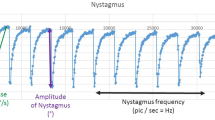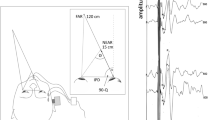Summary
In the alert monkey (Macaca fascicularis) vestibular nuclei neurons and eye movements were recorded during sinusoidal optokinetic stimulation in the horizontal plane at frequencies between 0.02–3.3 Hz. Maximal stimulus velocity was generally kept constant at 40 deg/s, except for frequencies above 1 Hz. Eye movements showed a nystagmuslike pattern up to 0.2 Hz with a gain (change in eye position/change in cylinder position) greater than 0.8; at frequencies above 1 Hz the gain dropped to 0.35 at 3.3 Hz. A decrease in gain was accompanied by an increasing phase lag. Recordings in the vestibular nuclei were obtained from ‘vestibular only’ and ‘vestibular plus saccade’ neurons. Neurons with a strong eye position signal (‘vestibular plus position’) were excluded. The vast majority (87%) of neurons were not modulated at 0.2 Hz or higher frequencies of sinusoidal optokinetic stimulation, and were classified as ‘low-frequency’ type neurons. Compared to the response at constant stimulus velocity, sensitivity (imp·s-1/deg·s-1) dropped to 72% at 0.03 Hz and 16% at 0.1 Hz. A few neurons (13%) responding at 0.2 Hz (sensitivity on average 65% of the constant velocity response) were classified as ‘high-frequency’ type neurons. They did not respond above 1.0 Hz and showed no modulation with individual eye movements. The results suggest that the activity in the groups of vestibular nuclei neurons tested here is insufficient to account for the eye movements in response to sinusoidal optokinetic stimulation at frequencies above 0.1 Hz. Thus additional neuronal mechanisms have to be involved in the generation of high frequency optokinetic responses, a likely structure being the flocculus in the cerebellum. Whether the ‘high-frequency’ type vestibular nuclei neurons play a role for this response has yet to be determined.
Similar content being viewed by others
References
Brodal A (1974) Anatomy of the vestibular nuclei and their connections. In: Kornhuber, HH (ed) Handbook of Sensory Physiology, Vol VI/1. Springer, Berlin Heidelberg New York, pp 239–352
Buettner UW, Büttner U, Henn V (1978) Transfer characteristics of neurons in the vestibular nuclei of the alert monkey. J Neurophysiol 4: 1614–1628
Büttner U, Buettner UW (1978) Parietal cortex (2v) neuronal activity in the alert monkey during natural vestibular and optokinetic stimulation. Brain Res 153: 392–397
Büttner U, Henn V (1981) Circularvection: psychophysics and single unit recordings in the monkey. Ann NY Acad Sci 374: 274–283
Büttner U, Meienberg O, Schimmelpfennig B (1983) The effect of central retinal lesions on optokinetic nystagmus in the monkey. Exp Brain Res 52: 248–256
Büttner U, Waespe W (1984) Purkinje cell activity in the primate flocculus during optokinetic stimulation, smooth pursuit eye movements and VOR-suppression. Exp Brain Res 55: 97–104
Cohen B, Matsuo V, Raphan T (1977) Quantitative analysis of the velocity characteristics of optokinetic nystagmus and optokinetic after-nystagmus. J Physiol (Lond) 270: 321–344
Duensing F, Schaefer KP (1958) Die Aktivität einzelner Neurone im Bereich der Vestibulariskerne bei Horizontalbeschleunigungen unter besonderer Berücksichtigung des vestibulären Nystagmus. Arch Psychiat Nervenkr 198: 225–252
Eckmiller R, Mackeben M (1978) Pursuit eye movements and their neural control in the monkey. Pflügers Arch 377: 15–23
Fuchs AF (1967) Periodic eye tracking in the monkey. J Physiol (Lond) 193: 161–171
Fuchs AF, Kimm J (1975) Unit activity in vestibular nucleus of the alert monkey during horizontal angular acceleration and eye movement. J Neurophysiol 38: 1140–1161
Godaux F, Gobert C, Halleux J (1983) Vestibulo-ocular reflex, optokinetic response, and their interactions in the alert cat. Exp Neurol 80: 42–54
Godaux E, Vanderkelen B (1984) Vestibulo-ocular reflex, optokinetic response and their interactions in the cerebellectomized cat. J Physiol (Lond) 346: 155–170
Gonshor A, Malcolm R (1971) Effect of changes in illumination level on electro-oculography (EOG). Aerospace Med 42: 138–140
Grüsser O-J, Pause M, Schreiter U (1982) Neuronal responses in the parieto-insular vestibular cortex of alert Java monkeys (Macaca fascicularis). In: Roucoux A, Crommelinck M (eds) Physiological and pathological aspects of eye movements. Junk Publ, The Hague, pp 251–270
Henn V, Cohen B, Young, LR (1980) Visual-vestibular interaction in motion perception and the generation of nystagmus. Neurosci Res Prog Bull 18: No 4
Keller EL, Precht W (1979) Visual-vestibular responses in vestibular nuclear neurons in the intact and cerebellectomized, alert cat. Neuroscience 4: 1599–1613
Lisberger SG, Fuchs AF (1978) Role of primate flocculus during rapid behavioral modification of vestibuloocular reflex. I. Purkinje cell activity during visually guided horizontal smooth-pursuit eye movements and passive head rotation. J Neurophysiol 41: 733–763
Miles FA, Fuller JH, Braitman DJ, Dow BM (1980) Long-term adaptive changes in primate vestibuloocular reflex. III. Electrophysiological observations in flocculus of normal monkeys. J Neurophysiol 43: 1437–1476
Paige GD (1983) Vestibuloocular reflex and its interactions with visual following mechanisms in the squirrel monkey. I. Response characteristics in normal animals. J Neurophysiol 49: 134–151
Robinson DA (1981) Control of eye movements. In: Brooks VB (ed) Handbook of Physiology, Sect 1: The Nervous System, Vol II, Part 2. American Physiological Society, Bethesda, MD, pp 1275–1320
Ter Braak JWG (1936) Untersuchungen über optokinetischen Nystagmus. Arch Neerl Physiol 21: 309–376
Trincker D, Sieber J, Bartual J (1961) Schwingungsanalyse der vestibulär, optokinetisch und durch elektrische Reizung ausgelöste Augenbewegungen beim Menschen. I. Mitteilung, Stetige Augenbewegungen: Frequenzgängige und Ortskurven. Kybernetik 1: 21–28
Waespe W, Büttner U, Henn V (1981) Visual-vestibular interaction in the flocculus of the alert monkey. I. Input activity. Exp Brain Res 43: 337–348
Waespe W, Cohen B, Raphan T (1983) Role of the flocculus in optokinetic nystagmus and visual-vestibular interactions: effects of flocculectomy. Exp Brain Res 50: 9–33
Waespe W, Henn V (1977a) Neuronal activity in the vestibular nuclei of the alert monkey during vestibular and optokinetic stimulation. Exp Brain Res 27: 523–538
Waespe W, Henn V (1977b) Vestibular nuclei activity during optokinetic after-nystagmus (OKAN) in the alert monkey. Exp Brain Res 30: 323–330
Waespe W, Henn V (1979) The velocity response of vestibular nucleus neurons during vestibular, visual and combined angular acceleration. Exp Brain Res 37: 337–347
Waespe W, Henn V (1981) Visual-vestibular interaction in the flocculus of the alert monkey. II. Purkinje cell activity. Exp Brain Res 43: 349–360
Author information
Authors and Affiliations
Additional information
Supported by Deutsche Forschungsgemeinschaft SFB 200 A 2
R.B. was a Alexander v. Humboldt fellow.
Rights and permissions
About this article
Cite this article
Boyle, R., Büttner, U. & Markert, G. Vestibular nuclei activity and eye movements in the alert monkey during sinusoidal optokinetic stimulation. Exp Brain Res 57, 362–369 (1985). https://doi.org/10.1007/BF00236542
Received:
Accepted:
Issue Date:
DOI: https://doi.org/10.1007/BF00236542




